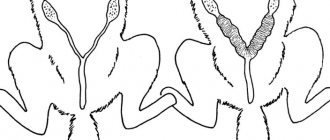10039Administration
1
Almost every owner who has cats has encountered a problem - the animal begins to vigorously scratch its ears, sometimes even to the point of bleeding. The most common reasons why a cat's ears itch are given in this article.
Ear scratching is a red flag that may indicate that your pet is sick. To avoid such problems, you need to regularly examine the animal to assess its health. Failure to promptly treat ear diseases and infections can cause your cat to develop serious hearing problems for life, including complete deafness.
© shutterstock
Causes of cat anxiety
In most cases, annoying itching is explained by parasitosis, allergic reactions and dermatitis, but sometimes the cause of shaking is a nervous disorder. Before contacting a veterinarian, check your pet for associated symptoms. This will help determine the probable disease and provide first aid.
Ear mites, or otodectosis
Mites that cause otodectosis infect the inner surface of the ear and strive to reach deeper layers. The advanced form of the disease is fraught with damage to the meninges and disturbances in the functioning of the central nervous system.
Due to the unbearable itching, the animal scratches itself until it bleeds. Also, when infected, the following is noted:
- abundant dark plaque inside the ears;
- head shaking;
- lethargy and fever.
The appearance of convulsions and seizures is a bad sign, indicating damage to the eardrum. To prevent this condition, it is important to consult a doctor at the first alarming symptoms.
Inflammation and tumors in the ear, including otitis media
The most common inflammatory disease affecting the ear canal is otitis media. Its main danger is possible hearing loss and impaired brain function.
Otitis media occurs as a complication of another pathology when pathogenic microorganisms enter the external auditory canal. As a result of infection, severe swelling occurs, accompanied by fever and loss of appetite. The cat's hearing is impaired, so he often tilts his head to the side or shakes it from side to side. Mucous or purulent discharge appears from the affected organ.
Tumors of the ear canal are divided into benign and malignant. The resulting new growths irritate the inner surface, so the pet constantly itches and presses its ears.
Allergy
If your cat scratches her ears, but their inner surface is dry and clean, check her for allergies. In addition to unbearable itching, the reaction to allergens is accompanied by lacrimation, runny nose, cough, redness and flaking of the skin. This reaction occurs when changing food, inhaling chemicals, tobacco, dust, pollen or other allergens.
Foreign object or water in the ear
The appearance of tremors is sometimes explained by a stuck foreign object or water. Carefully inspect the ear canal for blades of grass, sticks, sand or plant particles. In most cases, shaking helps clear the ear hole, but an object lodged too deeply and tightly can provoke an inflammatory process.
Hematoma and ear injuries
A hematoma is a consequence of a minor injury, which is a subcutaneous accumulation of blood. When it occurs, the affected area swells and turns red. Local temperatures rise. In severe cases, the animal develops a curvature of the auricle, an abscess and tissue death.
After a fight or fall from a height, it is better to show the animal to a veterinarian. The resulting injury may be accompanied by a concussion, damage to the cervical vertebrae or brain. In this case, the pet loses consciousness or rushes around the house.
Dirt and sulfur plugs
Earwax is a natural lubricant that cleanses the ear canal of dirt and protects it from bacteria. Not only its absence, but also its excess is harmful to the body. In the first case, the inner surface gradually becomes overgrown with dirt, and when the ears are rarely cleaned, wax plugs form, reducing hearing and increasing the likelihood of inflammation.
Flea infestation
Flea bites are often accompanied by allergies. A foreign protein injected into the body when feeding parasites causes severe scabies. Most fleas are also dangerous for people, so you can suspect an infection from bites on your own body.
Fungus
The cause of a fungal infection may be too frequent washing, which violates the natural protective barrier. The fungus causes a sharp and sour odor from the affected organ. The ears become red, swollen and flaky. A sick animal constantly itches and jerks its head, reacting aggressively or apathetically to its owners.
Dermatitis and notoedrosis
Dermatitis is an inflammatory skin lesion. It is caused not only by allergies and parasitosis, but also by other factors. If redness, swelling, itching and blisters occur, it is necessary to undergo a full diagnosis, as treatment will depend on the underlying cause.
Another possible cause is notoedrosis. This disease is caused by notoedres mites, which are easily distinguished by their unpleasant odor and dark gray discharge. Notoedrosis is difficult to tolerate in kittens and animals with chronic diseases. These mites are not dangerous for humans, since their skin is not suitable for their reproduction.
Neurological causes
Nervous shaking of the head is characteristic of encephalitis, strokes and traumatic brain injuries. Depending on the cause, this symptom is supplemented by:
- shaky and uncertain gait;
- inappropriate behavior;
- lack of reaction to light;
- making circular movements and loss of coordination;
- bumping into obstacles.
A sick animal should be shown to a doctor as soon as possible. This will help avoid relapses and death.
The cat scratches its ear and shakes its head: reasons
When a cat scratches its ear and shakes its head, it is important to know what to do to help your pet.
There are many reasons for the appearance of such symptoms. Veterinarians identify several diseases as the main ones. They are especially common in cats and can appear in an animal at any age.
Pets that have free access to the outdoors suffer the most from ear infections. Also, strange behavior can be caused by tumors in the ear cavity, allergies (especially if the allergen penetrates directly into the ear) and skin diseases.
A disease in an animal can be suspected if head shaking and scratching are more than one-time in nature and are accompanied by the following manifestations:
- the appearance of irritability;
- frequent shaking of the head, after which the cat keeps its head tilted to the side for some time;
- scratching in the ear area;
- redness and swelling of the ear;
- aggressive behavior of the pet in response to attempts to touch his head.
This symptomatology is typical for most ear diseases.
Ear scabies, ear mites (otodectosis)
Otodectosis is one of the most common ear diseases in cats , which quickly spreads from animal to animal, causing itching and inflammation in the ears.
The kitten may even die from the disease.
Infection most often occurs due to contact of a domestic cat with street relatives, who, as a rule, are carriers of the disease. Infection from dogs occurs in exceptional cases, since they are practically not susceptible to pathology.
Be sure to read:
What to do if the cat sheds hair and the whole house is covered in fur all year round
The mite parasitizes directly in the ear or on the skin next to it. The second option is noted less frequently. An accumulation of liquidish brown secretion appears in the ear, which dries and forms dense crusts.
As a result, the ear becomes dirty.
In a veterinary hospital, scraping determines the presence of adult parasites, its larvae and eggs. Treatment is carried out using drops or injections.
The first method is easier for the cat and is used in most cases. Injections against otodectosis are given to young animals with severe infection.
Notoedrosis
The disease is also caused by ticks . The parasites that cause this pathology are sarcoptoid mites, which settle in the skin not only in the ear area, but also throughout the body, causing itching.
The insect initially appears on the cat's head and, if left untreated, gradually spreads throughout the body. The skin in areas where mites are present becomes dry, a dense crust forms on it, which gradually cracks, leading to the formation of painful wounds. They often become infected, which aggravates the animal's condition.
Ear scabies, ear mites (otodectosis)
To determine the disease, a scraping with further examination is required. It is not possible to cure the pathology on your own, so a mandatory visit to a veterinarian is required. In advanced forms of the disease, therapy is complex and lengthy.
Important! If you suspect that your cat has a tick-borne infection, you should definitely contact a specialist. Treatment of the disease at an early stage will cost much less.
Fleas
This most common skin parasite in pets leaves bites that cause severe itching. Flea allergies in cats cause skin inflammation. Insects cause concern not only for cats, but also for their owners, as they bite all warm-blooded animals. It is necessary to remove the parasite as quickly as possible from the moment it appears in the animal.
Fleas, being in the ears of a cat, are almost inaccessible to her, and therefore they cause special concern there. The animal may scratch the area behind the ear vigorously until ulcers form.
Be sure to read:
Sores on a cat’s neck that itch and hair fall out: normal or pathological, reasons, what to do
Treatment of the problem comes down to removing parasites. For this purpose, drops on the withers or sprays are used. In severe cases, when it is not possible to remove fleas using conventional means, an antiparasitic injection is used.
Otitis (ear inflammation)
Otitis media, or inflammation of the inner ear, is a common condition in cats that can cause serious problems ranging from deafness to inflammation of the brain.
The cause of its appearance is fungal and bacterial diseases, severe hypothermia, allergies, a number of pathologies of internal organs, as well as the presence of a foreign object or insect in the ear.
Otitis media, or inflammation of the inner ear
For proper therapy, it is necessary to accurately determine what factors caused the development of the disease. To do this, a history is taken, a swab is taken from the ear, and in some cases a blood test is prescribed. If there is discharge of pus, this indicates a bacterial form of the disease.
Treatment depends on what caused the inflammation. In most cases, the use of general or local antibiotics is required. The affected ear is also usually washed to remove excess secretion.
Hematoma
Hematoma refers to the consequences of injury. Usually one side suffers. A hematoma is formed due to a blow to the ear, when blood from a damaged vessel, while maintaining the integrity of the skin, pours into the interstitial space.
Hemorrhage causes an unpleasant feeling of pressure in the damaged area, causing the cat to shake its head. Treatment is carried out only by a veterinarian. Often a blockade is enough, which will eliminate the discomfort until the hematoma resolves on its own. In more severe cases, surgery may be required to open the hemorrhage.
Sulfur plug
Ear cleaning can be done at a veterinary clinic or at home.
The problem only arises if the plug becomes very large. The animal does not experience pain, but loses hearing, which causes concern. It is enough to remove the plug for the cat’s condition to return to normal.
Ear cleaning can be done at a veterinary clinic or at home. At home, sulfur is softened with saline solution, and the cat shakes it out itself. The treatment process takes several days.
Examining the cat and diagnosing the problem
You can find out why your cat often shakes its head and ears after visiting a veterinary clinic. To make a diagnosis you will need:
- take urine and blood tests to determine deviations in basic indicators;
- undergo a bacteriological examination (bacterial culture), identifying the pathogen and its sensitivity to antibiotics;
- do ultrasound and x-rays necessary to detect internal pathologies, root causes and tumors.
The list of studies is individual and agreed upon locally. In addition to the above, the doctor can perform a biopsy, take a scraping or smear from the damaged area.
When is self-medication acceptable?
Doctors recommend avoiding self-treatment until a diagnosis is made. Due to an incorrect interpretation of the cause, the owner may ineffectively treat a completely different disease, contributing to the growth of complications.
At home, flea treatment, removal of wax plugs, dirt, foreign objects and water are acceptable. You can also try to eliminate the allergic reaction with an antihistamine, but it is better to consult your doctor first. He will tell you the exact dosage and guide you in further actions.
To kill parasites, use any anti-flea drops, tablets or sprays, not forgetting to wash your pet with a special shampoo. All personal belongings of the infected person will have to be thrown away. Please note that all pets that have been in contact with the sick person will need to be treated for parasites.
Sulfur plugs are soaked with saline solution or a special lotion. Place a couple of drops in each ear three times a day for a week. If there is no improvement, contact your doctor immediately.
Removing a foreign object is only permissible if it is close to the entrance. If it is too deep, the eardrum can be damaged. For the same reason, you should not clean the ear canal of dirt and water with a cotton swab. A regular cotton pad rolled into a tube will do.
Veterinarian-guided therapy
The final therapy depends on the diagnosis and general condition of the animal. In especially severe cases, surgical intervention is resorted to. Surgery is necessary if necrosis, abscess, advanced hematoma, narrowing of the ear canal, or deep-lying foreign object is detected. In all other cases, they are limited to taking medications:
- antibiotics – for infections;
- antihistamines – for allergies and allergic dermatitis;
- antiparasitic – for tick and flea infestations;
- anti-inflammatory, painkillers and immunomodulators - to relieve associated symptoms and boost immunity.
Regardless of the affected area, the prescribed medications are dripped into both ears. For better divergence of droplets, a light massage of the auricle is recommended. The resulting crusts are soaked and removed, treating the damaged skin with disinfectant solutions.
Hematomas are eliminated with absorbable ointments and cold compresses, as well as UHF therapy. In severe forms, the accumulated fluid is pumped out with a syringe.
Neurological diseases are the most difficult to combat. Treatment of the resulting disorders is individual, and the prognosis directly depends on the degree of damage to the meninges.
Ear mite infection, or otodectosis
This disease is caused by a microscopic parasitic mite that can live in the ear canal of cats, ferrets and dogs.
Ear mites are easily transmitted through contact with a sick animal, and also survive for some time in the environment, which makes infection possible through indirect routes. It is common to think that when an ear mite infestation occurs in a cat's ears, there will certainly be brown discharge and the cat will scratch the ears a lot, but this is not always the case. Some animals have no discharge at all, and the degree of itching can vary greatly between cats. Most often, domestic cats become infected with ear mites during trips to the country or if a new animal, for example a small stray kitten, is brought into the house. Both ears are always affected.
Prevention and hygiene
Prevention of ear pathologies is based on hygiene and maintaining immunity that can fight off infections and parasites. For the health of your pet, try to prevent hypothermia and never stop treatment until approved by your veterinarian.
Ear cleaning
Teach your pet to clean his ears from early childhood. This will help avoid stress and aggressive behavior in the future.
At first, you will have to use thick fabric to protect yourself from clawed paws. Having become accustomed to new sensations, the cat will be given control without a “straitjacket.” Try to carry out the procedure in a calm environment, not forgetting about stroking and talking with your pet. When finished, don’t forget to treat the daredevil with a treat.
For cleansing, use special lotions or saline solution. Place a couple of drops inside the sink and massage it gently. You can also clean it using a cotton swab dipped in warm water. Gently wipe the inside of the ear with it, removing accumulations of wax, at least once a month, but not more than once a week.
Regular removal of parasites
Another important point is antiparasitic treatment. In addition to taking quarterly anthelmintic medications, it is important not to forget about flea and tick protection. Special collars and drops on the withers are suitable. If your pet has free access to the street, then do not forget to inspect its fur and skin after returning home.
Vaccinations
Annual vaccination provides immunity against the most common infections, increasing the body's defenses. Vaccinations not only serve to prevent specific diseases, but also stimulate the functioning of the immune system.
Precautions when swimming
Cats are bathed very rarely, as they are clean animals. When washing, avoid getting water into your ears. To do this, simply not washing your hair is enough. Unlike the human head, this part of the body practically does not get dirty, since it is devoid of sebaceous glands. After taking a bath, dry your pet with a towel and blot his ears with a cotton swab.
If your cat shakes its head too often, do not self-medicate, show it to a doctor. The earlier the diagnosis is made, the higher the chances of recovery without complications.
The article is for informational purposes only. Contact your veterinarian!
Treatment methods
Head tremors of a physiological nature, for example, before preparing to jump or during sexual activity of an animal, do not require treatment. In case of pathological processes, a mandatory examination in the clinic, examination, and hardware diagnostics are required. Antiparasitic drops in the ears are prescribed as a treatment for otodectosis. In the case of otitis media, it is necessary to include a group of antibiotics. Diseases of a neurological nature or failure of internal organs require specific treatment. In this case, only an experienced veterinarian can prescribe a complex of drugs.
Lovers of fluffy kittens need to constantly monitor the health of their pet, promptly bring it to the clinic for diagnostics, and undergo preventive examinations and vaccinations. A responsible attitude will help prevent illness and make your four-legged friend happy and active.











